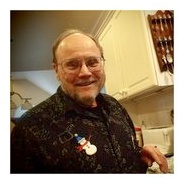
Chuck Pfeifer
Thirty-seven years — that’s how long I have been associated with Holy Wisdom Monastery (HWM). Now Jean and I are leaving, moving to Boston to be closer to our daughter, her husband and our first grandchild.
Thirty-seven years is a long time, and my mind is flooded with images. There are the sisters, actual monks, Mary David, Joanne, Lynne. When I first visited the center, as a Protestant I didn’t know what to expect of ‘nuns.’ I imagined them as somber figures in long flowing habits. Instead, these nuns wore street clothes. I did see a photo of Mary David in her habit, but she was racing across the prairie on a horse, not very nun-like. Then there was Joanne with her sparkling wit. Nuns were supposed to be serious. Had I encountered Lynne back then, I would have thought, “She can’t be a nun. She isn’t even Catholic.” I’ve learned a lot about monasteries in 37 years.
I first visited HWM (then St. Benedict Center) in the ’70s when I was the director of Madison-area Urban Ministry (MUM). I rode my bike weekly to the monastery with my twenty pound Kaypro computer strapped onto the back. My rented room provided a quiet place where I could meditate and write. I still remember the cross on the wall above my desk. I smile when I recall a Jewish friend saying, “It’s such a spiritual place, but I had to put the cross in the desk drawer when I was writing.”
One of the major charisms or callings of Benedictine monasteries is hospitality. I remember the many people who extended hospitality to me through the years. In addition to the sisters, there were the staff, women and men for whom the monastery was much more than a job site. They were committed to welcoming the stranger. Gradually I, the stranger, became a friend. There were others too who experienced this hospitality — members of Sunday Assembly, oblates, volunteers and those who came for spiritual guidance, retreats and seminars.
I left MUM with burnout in 1998 and was welcomed into this place. I was given an office and a computer. I served as volunteer staff, co-leading seminars. I was also trained as a spiritual guide. In these roles I gained a greater appreciation of Benedictine values: hospitality; listening with the ear of the heart; balancing work, prayer and leisure; humility — the honest appraisal of one’s own strengths and weaknesses.
But overarching these values, I experienced a commitment to something that transcended the monastery — the Mystery that many call God. For me, this Mystery is most accessible in nature. And nature is present in all her glory in the land surrounding the monastery. I have walked this land hundreds of times, and each time I am awed by its beauty.
During the cold, sunny days of winter, the prairie glistens white with snow, and Lost Lake is a smooth sheet of ice. The trees in the oak grove stand as blackened sentinels in a sea of diamonds as sunlight sparkles on the snow. In spring the prairie comes alive. Green shoots laden with buds push through the dried stubble of last year’s growth. Geese and ducks return to Lost Lake. Summer brings warm breezes and a prairie bursting with blooms. Bees buzz around blossoms. Birds chirp and flit about. Prairie grasses wave in the wind. When summer turns to fall the oak trees drop their leaves making the ground soft and spongy as the natural cycle of death and rebirth continues. Last fall I saw a doe and two fawns in the apple orchard. Brother Tom, a wild turkey, visited us during evening prayer, pecking at his reflection in the windows. Sandhill cranes and geese winged overhead, migrating south.
Thirty-seven years ago, I was pretty clear on what it meant to be spiritual. I came to the monastery to recharge my batteries so that I could reenter the struggle for justice, opposing the power of those who dominated, while empowering the weak.
I now have a different understanding of spirituality. I meditate and pray so that I can be more in tune with my own depths, so that I can come alive myself. When this happens, it is as if I am being helped by hidden hands. I am able to identify and act on new possibilities that bring life to the world around me.(1)
In closing then, I’m grateful for my 37 years at this monastery. I’m grateful for the people who stood with me on my journey. I’m grateful for the Mystery that surrounds and sustains us.
- Thanks to Joseph Campbell — The Power of Myth p. 150 & p. 183
Chuck Pfeifer writes a monthly blog, “Living With Soul.” It is available at drchuckpfeifer.blogspot.com. It is also available on his “Living With Soul” page on Facebook.


Comments 8
Thanks for your reflection, Chuck. I’m going to miss having you around at Holy Wisdom Monastery!
Blessings, Chuck, to you and your family, and to Holy Wisdom Monastery.
Thanks Debbie for the warm wishes.
Blessings,
Chuck
thank you, chuck, for all the wonderful things you’ve done for madison. thanks for sharing your energy and vision. you are an inspiration to me.
Thanks Bill,
Back acha – You inspire me as well.
Blessings,
Chuck
Thank you for this reflection, Chuck. Your imagery brought to mind some of the things that make Holy Wisdom Monastery a special place. All the best to you and your family as you make your move.
Thanks Julie.
Blessings,
Chuck
Hi chuck, thank you for your lovely reflections about the monastery and the grounds. I too have been richly blessed with their gift of hospitality. Indeed a place to gain balance in ones life. You will be missed. Blessings, Jan Summers